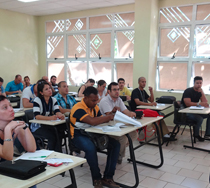From Klinberg to date: higher education and the demands on evaluation
Keywords:
EDUCATION, HIGHER, COMPETENCY, EVALUATION, TEACHING, LEARNING.Abstract
Introduction: in the process of evaluation of learning, the need for a developing and integrating character has been implicit in both the international and national spheres.Objective: to establish methodological recommendations based on an integrative conception of the evaluation of learning from the discipline of General Pedagogical Formation.
Development: in order to move towards excellence in the direction of the Aulic Pedagogical Process, it is necessary that creation be an incentivecomprise all the factors that intervene in the educational system. Professors and students are direct protagonists of the evaluation process, other external evaluators are farther away from the process, and many times theory takes precedence over practice and vice versa. The idea is to fulfill this principle (theory-practical unit), and that the act of evaluating learning process constitutes an enhancer of the pedagogical processes of excellence, and its quality, which will contribute to the effective educational institutions and systems
Conclusions: the bridging of evaluation of the teaching-learning process in the methodological work is a need for the evaluators and for those assessed, who must begin by resizing the functions of teaching to search for an integrative conception that leads to the fulfillment of the methodological recommendations from their dimensions and indicators, as well as making evident the unity of the affective-cognitive-value in the actions of those assessed.
Downloads
References
1. López Miari CL. El aprendizº en el punto de mira. RevMendive Científico Pedagógica [Internet]. 2013 [citado 02/07/2018]; 41(2012): [aprox. 5p.]. Disponible en: https://dialnet.unirioja.es/descarga/articulo/6320228.pdf
2. Cruz-Palacios Y. La comunicación: incidencia en la formación del profesional de la educación. Ciencias Holguín [Internet]. 2013 [citado 02/07/2018]; XIX(2): [aprox. 12p.]. Disponible en: http://www.redalyc.org/articulo.oa?id=181527530010
3. de la Herrán A. Enfoque radical e inclusivo de la formación REICE. Revista Iberoamericana sobre Calidad, Eficacia y Cambio en Educación [Internet]. 2014 [citado 02/07/2018]; 12(2): [aprox. 2p.]. Disponible en: http://www.redalyc.org/pdf/551/55130462008.pdf
4. Rodríguez Ramírez AM. Estilos de enseñanza- aprendizaje para mejorar la práctica docente con alumnos del nivel secundaria. [Tesis]. México: UNIVERSIDAD TECVIRTUAL ESCUELA DE GRADUADOS EN EDUCACIÓN; 2012. Disponible en: https://repositorio.itesm.mx/bitstream/handle/11285/619670/TESIS%20Ana%20M%20Rodr%C3%ADguez%20R.pdf?sequence=1
5. Bonilla García C, Medina Zárate J. Sentidos otorgados a las estrategias pedagógicas para incentivar la motivación en un proceso de aprendizaje de matemáticas en quinto de primaria del Colegio Unidad Pedagógica. [Tesis]. Colombia: Pontificia Universidad Javeriana; 2014. Disponible en: https://repository.javeriana.edu.co/bitstream/handle/10554/19075/BonillaGarciaCamilo2014.pdf?sequence=1
6. Largo Arenas E A, García Navarro X, Bermúdez López IL. LA PREPARACIÓN DEL DOCENTE DE LA ZONA RURAL, PREMISA PARA UNA EDUCACIÓN INCLUSIVA. Rev Universidad Sociedad. [Internet]. 2018 [citado 02/07/2018]; 10(3): [aprox. 4p.]. Disponible en: https://rus.ucf.edu.cu/index.php/rus/article/view/905/993
7. Durán Palacio NM. Psicología y Desarrollo Humano: Razones para una Nueva Manera de Pensar. Revista De Psicología GEPU [Internet]. 2014 [citado 02/07/2018]; 5(2): [aprox. 8p.]. Disponible en:https://revistadepsicologiagepu.es.tl/Psicolog%EDa-y-desarrollo-humano-d--Razones-para-una-nueva-manera-de-pensar.htm
8. SANDOVAL GANOZA RY. Entre la conciencia y la existencia: La hermenéutica como “crítica inmanente” a la fenomenología trascendental [Tesis]. Lima, Perú: UNIVERSIDAD Jesuita Antonio Ruiz de Montoya: Facultad de Filosofía, Educación y Ciencias Humanas; 2015. Disponible en:
9. González Cruz M. ORIENTACIONES DIDÁCTICAS PARA LA REALIZACIÓN DEL TRABAJO INDEPENDIENTE EN LA EDUCACIÓN SUPERIOR. TENDENCIAS PEDAGÓGICAS [Internet]. 2014 [citado 02/07/2018]; 24: [aprox. 20p.]. Disponible en: https://dialnet.unirioja.es/descarga/articulo/5236978.pdf
10. González González C. Papel del método de enseñanza y sus procedimientos en la formación de docentes creativos. Revista Electrónica EduSol [Internet]. 2014 [citado 02/07/2018]; 14(49): [aprox. 12p.]. Disponible en: http://edusol.cug.co.cu/index.php/EduSol/article/view/37/pdf_20
11. Paolinelli Schulz C. Verdad e historia del ser en el pensamiento de Martin Heidegger. [Tesis]. Universidad de Chile Facultad de Filosofía y Humanidades; 2016. Disponible en: http://repositorio.uchile.cl/bitstream/handle/2250/141634/Verdad-e-historia-del-ser-en-el-pensamiento-de-Martin-Heidegger.pdf?sequence=1&isAllowed=y
12. Moreno Iglesias M. Propuesta metodológica para evaluar la eficacia del proceso pedagógico áulico en Secundaria Básica. [Tesis]. La Habana. Cuba. Instituto Central de Ciencias Pedagógicas; 2005. Disponible en: http://rc.upr.edu.cu/bitstream/DICT/1853/1/Moreno_05.pdf

Downloads
Published
How to Cite
Issue
Section
License
Authors who have publications with this journal agree to the following terms: Authors will retain their copyrights and grant the journal the right of first publication of their work, which will be publication of their work, which will be simultaneously subject to the Creative Commons Attribution License (CC-BY-NC 4.0) that allows third parties to share the work as long as its author and first publication in this journal are indicated.
Authors may adopt other non-exclusive license agreements for distribution of the published version of the work (e.g.: deposit it in an institutional telematic archive or publish it in a volume). Likewise, and according to the recommendations of the Medical Sciences Editorial (ECIMED), authors must declare in each article their contribution according to the CRediT taxonomy (contributor roles). This taxonomy includes 14 roles, which can be used to represent the tasks typically performed by contributors in scientific academic production. It should be consulted in monograph) whenever initial publication in this journal is indicated. Authors are allowed and encouraged to disseminate their work through the Internet (e.g., in institutional telematic archives or on their web page) before and during the submission process, which may produce interesting exchanges and increase citations of the published work. (See The effect of open access). https://casrai.org/credit/


